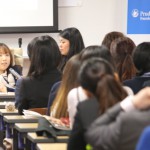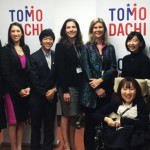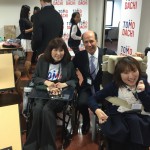TOMODACHI Generation: Megumi Takahashi
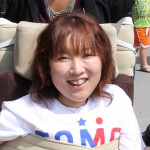 Megumi Takahashi
Megumi Takahashi
Born in Miyagi prefecture, Ms. Takahashi currently works for CIL Tasuketto in Miyagi, the only center in Tohoku that is supported by people with disabilities. She now lives by herself with support from an assistant. In the summer of 2015, she participated in the TOMODACHI ADA25Lead On! Program and visited the United States along with other young leaders in Japan involved in similar work. She participated in a conference commemorating the 25th anniversary of the enforcement of the American with Disabilities Act (ADA) and various other activities, sharing experiences and what they have learned with the counterparts in the United States.
Ms. Takahashi participated in the TOMODACHI Generation Summit 2015 on November 8. She had an opportunity to present to approximately 140 alumni. Her speech is below:
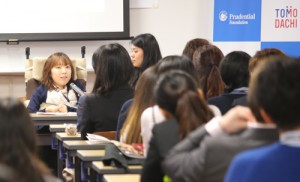 Hello everyone. My name is Megumi Takahashi. I am from Sendai, the capital city of the Miyagi Prefecture situated in the northwestern part of Japan. I currently work at CIL Tasuketto, which is the only center in the Miyagi Prefecture that allows and supports the physically challenged to live independently.CIL stands for “Center for Independent Living”. This summer, I participated in the TOMODACHI ADA Lead On! Tour. Today, I am honored to be able share this experience and the subjects I am passionate about. I am also looking forward to meeting new “TOMODACHI” who have also participated in many other inspiring programs.
Hello everyone. My name is Megumi Takahashi. I am from Sendai, the capital city of the Miyagi Prefecture situated in the northwestern part of Japan. I currently work at CIL Tasuketto, which is the only center in the Miyagi Prefecture that allows and supports the physically challenged to live independently.CIL stands for “Center for Independent Living”. This summer, I participated in the TOMODACHI ADA Lead On! Tour. Today, I am honored to be able share this experience and the subjects I am passionate about. I am also looking forward to meeting new “TOMODACHI” who have also participated in many other inspiring programs.
Let me begin with an introduction about myself. Shortly after birth, doctors diagnosed me with Werdnig-Hoffmann Disease, which is a disorder that causes muscles to gradually get weaker. As a child, I was unable to walk and always used a wheelchair. But this did not stop me from being a child full of curiosity, and I loved to play and explore outside with my friends. I attended a normal public elementary school and middle school, and studied the same curriculum as my peers who were not physically challenged as I was. My teachers and classmates were always there to support me, so my parents only needed to worry about dropping me off and picking me up from school. That is probably why I didn’t fit in with other so-called “people with disabilities”. Looking back, I realize now that I was trying to deny my own disability back then.
Throughout my adolescence, I began to notice the differences between myself and others, and like any other teenagers of my age, became very conscious of what others thought of me. I avoided speaking up and became reluctant in expressing my honest feelings. After middle school, I left my parents and lived at a home that was adjacent to a special needs high school. That was my first real encounter with a world that encompassed people with varying disabilities. Contrary to my expectations, many people there had big dreams and were always challenging new things. Seeing this encouraged me to go out of my comfort zone.
Then I came across “CIL Tasuketto”. The CIL – independent living center – gives peer support to people with disabilities who wish to live independently. This is when I started aspiring for an independent life for myself. Later on, I went to a correspondence university with a welfare course, and became more eager to engage with other similarly challenged people. My dream of living independently finally became a reality in March 2014.
Having been introduced by CIL, I participated in “TOMODACHI ADA25 LEAD ON! TOUR” this July. I had three objectives when going to Guam, America. My first objective was: “To see with my own eyes the country that enacted the Americans with Disabilities Act (ADA) which was the first law in the world that prohibits discrimination against people with disabilities”. My second objective was: “To learn the method to find budding young talents among young people with disabilities”. My third objective was: “To empower myself by meeting leaders who were women and also people with disabilities”.
In America, I witnessed first-hand the various efforts communities made to grant easy access for people with mobility impairment. What inspired me the most was to see people with disabilities actively taking leadership roles. I realized the power of people to connect, and felt that I was treated equally as a person. However at the same time, I also discovered that America still had to contend with many challenges. For example, I realized that America is still developing towards becoming completely barrier-free, not only in the aspects of nursing care insurance but also in aspects such as issues facing minority groups. In addition, I noticed some significant differences comparing the streets in America and in Japan – helpers walking along with people with disabilities were less visible, and we met less elderly people with disabilities compared to the younger generations. Without the opportunity of traveling to America, I would not have been able to notice these differences. The differences were not only apparent on the streets but also in the institutions and systems of both countries. America is a country that puts an emphasis on the protection of human rights. Japan on the other hand emphasizes the importance of nursing care insurance. Each system has its own strengths and room for improvements.
Both countries have things to learn from each other – I believe that we must learn from each other’s strengths, and innovate ways of solving issues to create new advanced institutions. The leaders of the next generation like us must take on the roles to tackle these challenges together. We can each play a role in this endeavour.
Did you know that Japan will be enforcing the Act on the Elimination of Disability Discrimination April next year? This law has addressed many issues in Japan in order to eliminate the discrimination against those with disabilities. The notable feature of this Act is its emphasis on protecting human rights. In America I felt that I was truly treated equally. I think this is one of the strengths of America which Japan can learn from to prioritize the “right of a person”. This right should be the basis to build a new system.
Throughout the TOMODACHI ADA Lead On! Tour, I not only learned about the institutions and systems of both countries but most importantly I also learnt about myself. Through self-reflection, I became conscious of my flaws that I sometimes overlooked in the past. I used to lack confidence and be reluctant to speak up. But my experience in America very much empowered me, as I learned that “it is okay to move forward even when I don’t have all answers” and that “I must have faith in myself”. I also recognized the existence of my many friends: my “TOMODACHI”, in America and here in Japan. In the future, I may have to go down a rocky path. Yet, I am certain that I will now be able to overcome the challenge. I will gain confidence through my work at CIL and, I would like to take on an active role as a member of the next generation of leaders.
Finally to the TOMODACHI Alumni, to the many companies that support our activities and to every staff here today: in order to create a better society the first step is to know more about each other. Take initiative to learn more about one another. A simple conversation can make all the difference. This will help create a society where people will not be judged by their age, abilities and disabilities, and will help create a society where people will support one another, learning from each other’s strengths. I am eager to play my role in realizing that goal as a proud alumna and a member of the TOMODACHI Generation.
Thank you for listening.

